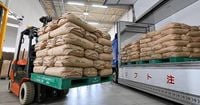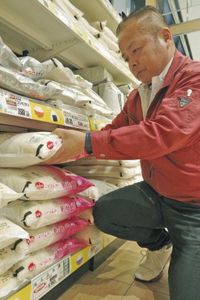On April 18, 2025, the Ministry of Agriculture, Forestry and Fisheries (MAFF) announced the distribution status of the first release of government reserve rice, approximately 140,000 tons, which took place from March 17 to March 30, 2025. The report revealed that only a small fraction of this rice has reached retail stores, which has raised concerns among consumers about the ongoing high prices of rice despite the government’s efforts to alleviate the situation.
The prices at which retailers, including supermarkets, purchased polished rice from wholesalers were set at 34,114 yen per 60 kilograms before tax. This translates to about 3,070 yen per 5 kilograms after tax. Notably, this price is nearly 30% lower than the average price of rice sold at supermarkets nationwide during the week of March 31 to April 6, 2025, which was 4,214 yen per 5 kilograms.
Despite these price reductions, the government's release of reserve rice has not yet led to a significant decrease in retail prices across the country. MAFF reported that only 4,071 tons, or about 2.9% of the total released, were transferred from the government to distributors in the initial two weeks. Out of this amount, 2,761 tons were sold to 13 wholesalers, indicating a slow distribution process.
The selling price to wholesalers for brown rice was set at 22,402 yen per 60 kilograms before tax. This price is 1,050 yen higher than the price at which distributors purchased it from the government (21,352 yen before tax). However, the additional markup is approximately half of the standard distribution costs, which typically average around 2,000 yen.
Further analysis of the distribution process revealed that from the wholesalers, only 426 tons of polished rice were sold to 137 retailers, while 35 tons were sold to eight businesses in the food service industry. The selling price to the food service sector was 32,920 yen per 60 kilograms before tax.
During a press conference following a cabinet meeting on April 18, Agriculture Minister Takashi Eto noted, “It is clear from the numbers that distributors are simply adding transportation costs and are not making a profit.” He also pointed out a potential issue where wholesalers might be blending relatively inexpensive reserve rice with the same brand of rice held in stock to lower the price further.
As the rice distribution situation continues to unfold, concerns remain about the accessibility of the released reserve rice to consumers. Many individuals are questioning why, despite the government’s efforts to release reserve rice, prices remain high and store inventories are low. Experts have indicated that the delay in distribution is largely due to logistical issues, including truck shortages and the time required for rice milling.
According to MAFF, in the two auctions held in March 2025, JA Zen-Noh secured approximately 94% of the total 212,132 tons available. However, by March 30, only 1% of the released reserve rice had reached wholesalers, and a mere 0.3% had made it to retailers. This has led to frustration among consumers who are still experiencing high prices at stores.
In response to these concerns, MAFF has expressed optimism that as the distribution process stabilizes, more of the reserve rice will become available in stores. They have also released information regarding the relative transaction prices at which rice collectors and wholesalers buy and sell rice. The average price of 2024 rice (for staple food) up to March 2025 was reported at 24,500 yen, including tax, per 60 kilograms across all brands, marking the highest level since 1990.
However, in March 2025, the average price fell by 2% (609 yen) from the previous month to 25,876 yen, a decline attributed to the impact of reserve rice being sold at lower prices. This marks the first price decrease in eight months, raising hopes that retail prices may soon follow suit.
The situation varies significantly across different regions, particularly in the Hokuriku area. In Fukui Prefecture, where JA Fukui participated directly in the reserve rice auction, some local supermarkets received the rice quickly through wholesalers and sold out immediately. Conversely, in Ishikawa Prefecture, wholesalers are gradually receiving shipments, but the timeline for distribution remains uncertain. In Toyama Prefecture, there are reports from wholesalers indicating that no reserve rice has been received at all.
As the rice market continues to be a focal point of concern for consumers, the Ministry of Agriculture, Forestry and Fisheries is under pressure to ensure that released reserve rice effectively reaches the market and contributes to lowering prices. The hope is that the next announcement regarding average rice prices will reflect the recent decreases in transaction prices, providing some relief for consumers who have faced rising costs for an extended period.
Ultimately, the effectiveness of the government’s reserve rice release program will depend on how quickly and efficiently the rice can be distributed to retailers and, subsequently, to consumers. As the situation develops, stakeholders from farmers to consumers are keenly watching the market dynamics to see how this initiative will unfold and impact rice prices in the coming weeks.









